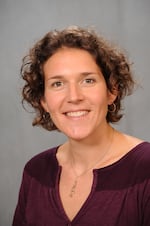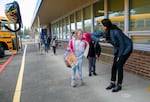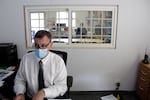As schools start to open their doors to in-person learning, most of them for the first time since March 2020, parents and teachers are beyond concerned.
They’re confused, angry — and afraid.
“Holy Batman, let me count the ways,” wrote Gretchen Grey-Hatton from Vancouver, in comments responding to OPB’s survey. “I’m worried that last year’s more successful mitigation measures won’t be as effective against Delta. I’m concerned that the toxic nature of the political discourse around basic medical guidelines like masking, distance, and vaccination will foster unsafe and negative environments in which to have conversations within school communities…” and her list continued.
Related: Oregon Department of Education: Full-time school in the fall, COVID-19 protocols no longer required
“Terrified” is the word several people used in responses they sent to OPB in recent days, as they considered the risks at school with children returning to class — many of them unable to access a vaccine due to their age.
OPB heard from over a thousand parents, teachers and staff members, and a few students, about their questions and concerns regarding the new school year.
Schools across Oregon are opening to in-person learning, even as case numbers among Oregonians — including school-aged children — have risen dramatically in recent weeks. When schools closed back in mid-June, pediatric cases of COVID-19 were at their lowest point in almost a year — a little over 200 cases total.
But children’s case numbers have skyrocketed to 1,871 in the two months up through Aug. 20. The lion’s share of those cases are among 12-17 year-olds, who can get vaccinated (though according to state data, their vaccination rates are the lowest rate of any age group). More than 600 cases involve school-aged children who are too young to be eligible for the vaccine.
State leaders announced in June that school districts would be required to offer full, in-person instruction to every student in the state. That was back when COVID-19 case numbers were still quite low. But updated guidance earlier this month maintained the in-person requirement.
‘Scared to death I will lose my kids’
Currently, only students 12 and older are able to be vaccinated against COVID-19. And while teachers and school staff will be required to be vaccinated by October 18, that leaves the state’s younger students without the vaccine to help protect them.
Some respondents expressed concern about returning unvaccinated students to the classroom.
“I’m scared to death that I will lose my kids,” said Merritt Sansom, a Portland Public Schools teacher whose children attend school in the North Clackamas School District.
Sansom asked why schools can’t wait until younger students are eligible to be vaccinated.
Dawna-Beth McDonald’s fifth-grader attends school in the Three Rivers School District in Southern Oregon’s Josephine County where vaccination rates are hovering around 46%. She’s opted for online learning.
“I want my son in school,” she said. “But opening up right now is beyond insane. We will see school closures all over the place due to children and staff falling ill. I refuse to put my only child in harm’s way and am not receiving any help whatsoever from the school.”
Related: Oregon to require health workers, school staff be vaccinated
Dr. Malaika Little is a pediatric infectious disease specialist and director of the inpatient hospitalist team at Randall Children’s Hospital at Legacy Emanuel, in North Portland. She’s also a parent with a school-aged kid.
She said she understands parents’ anxieties about children returning to the classroom, but she said currently the risk that children will die from COVID-19 is very low, and cases tend to be milder in children.
“We’re fortunate that COVID-19 does not seem to be a virus … that children are dying a lot from,” she told OPB. “There is a very, very low ... ‘case fatality rate. ”

Dr. Malaika Little
Legacy Health
Little did note that the delta variant is different from the original strain of the COVID-19 virus. She also said there are always other factors that may cause people to be sicker.
Related: Portland pediatric infectious disease specialist addresses back-to-school concerns
“There are some risk factors such as if you already have a lung problem, obese children, if you already have another medical condition such as sickle cell disease. Those are all reasons why some kids may get sicker than others,” Little said.
There have been two pediatric deaths reported due to COVID-19 in Oregon since the pandemic began. Unintended injuries, homicide and cancer are all far more significant causes of death in school-aged children.
The Oregon Health Authority has found that 1.2% of children nine and under who have tested positive for COVID-19 have ended up in the hospital. The hospitalization frequency is 0.8% among young people 10-19. Those are the lowest levels of hospitalization of any age group in the state. Out of 33,661 confirmed or presumptive COVID-19 cases among children in the state, OHA has documented 40 cases of multisystem inflammatory syndrome in children, or MIS-C, which includes fever, as well as problems to other systems, such as renal, cardiac or neurological.
Concerns about inhibiting freedom
A number of Oregonians contacted OPB with concerns in the other direction: they’re concerned that the stringent rules take control away from local decision-makers, and inhibit the freedom of individual students, staff and parents. A teacher in Tillamook told OPB they were opposed to putting “poison” in their body. A high school student in Albany questioned the mask mandate. And a parent in the Bend-La Pine Public Schools argued that the mask and social distancing requirements were going to ruin their child’s last year of high school.
Parents of younger children have also expressed concerns about potential downsides of enacting COVID-19 rules. They said students could have trouble learning when they can’t see a teacher’s facial cues, and kids with speech difficulties may struggle further having to talk through masks. Some parents anticipated conflicts in class, and unintended consequences, such as social-emotional difficulties, from mandates such as mask-wearing.
Related: Threats, vandalism worry teachers as parents object to mask rules, curriculum
“I think it’s too early to really know the long-term changes in that,” Little said, of how mask rules might affect the social-emotional development of kids. But she countered that she believes, “Our children are quite resilient and they will weather through this and be successful.”
Mitigating COVID-19 risk from the band room to the lunchroom
A full-time return to school buildings means a full-time return to lunch. Before the pandemic, that meant students in a crowded cafeteria, sitting next to each other.
Last year, school districts may have had smaller groups of students to serve during the day, or sent students home with lunch.
This school year is likely to be different, and several respondents to OPB’s survey mentioned lunch as a concern — in regards to whether students would be appropriately distanced to take off their masks and eat.
Beaverton parent Jenny Day said she was most concerned about times her child might not have a mask on, “primarily lunchtime.”
“How are masks effective throughout the day when unvaccinated students spend twenty minutes at lunch with only three feet of social distancing at the most?” Day asked in her response to the OPB survey.

A student touches elbows with a teacher as she leaves hybrid school at Ellsworth Elementary School in Vancouver, Wash., March 1, 2021. This week, students in Oregon and Southwest Washington are returning to school, and now it's in-person, full time.
Kristyna Wentz-Graff / OPB
The Oregon Department of Education points to guidance from the Centers for Disease Control and Prevention, which says distance should be maximized “as much as possible” while eating.
Oregon’s largest school district, Portland Public Schools, has announced it will hold lunch outside for at least the first six weeks of the school year.
Dr. Little said it’s encouraging to see districts like PPS choosing to have outdoor lunches.
“I think it does seem that schools are embracing this and looking at unique ways to handle that,” she said. “I have concerns, but I think there is real potential to think in an innovative way, and I do think we can all do this safely.”
Little said some measures, like staggering the times when students have lunch, could help in reducing the risk of COVID-19 transmission.
Parents have also expressed concern about other parts of the school day, like music or physical education.
Bill Beers is a parent of two students, both vaccinated, in the Tigard-Tualatin School District. He’s worried about them playing their woodwind instruments in band practice safely.
“I am skin-crawlingly uncomfortable with them in band practice, collaboratively spewing out germs into the band room, and breathing it all in,” Beers wrote.
Parents also expressed concern about indoor physical education classes. CDC guidance recommends universal masking.
Under a statewide mandate, masks are required in all K-12 schools. But there are places that the order doesn’t cover — like the school bus, where masks are still required under a CDC rule.
And when it comes to sports, masks are not required indoors or outdoors for students when practicing or playing a competitive sport. Students not actively participating in the sport are required to wear a mask, as are students in the weight room.
Who’s enforcing the rules?
Despite all the rules around masks, parents, students and teachers have expressed concern about enforcement of this and other rules, including distancing.
Greta West is a parent and employee at a Portland high school. PPS has information responding to distancing concerns, saying the “overwhelming majority” of classrooms will be able to maintain three feet of distance.
West isn’t so sure.
“I know that the school where I work is overenrolled by hundreds of students, and our class sizes will be over 30,” West said.
West also shared concerns about kids coming to school sick.
Related: Oregon school superintendent coaches parents on how to escape mask rules
“There will be many children whose parents are not vaccinated,” West said. “I’m also worried about kids coming to school sick because parents need to work.”
Others questioned how the state will ensure that COVID-19 rules are enforced faithfully statewide. A teacher in a school district in the Columbia River Gorge, who declined to be identified, or have their district identified on the advice of their union, said they’d already seen the mask mandate go unfollowed before students arrived in school buildings.
“How will you make sure everyone in the districts are following rules?” asked the educator. “We have been in the in-service for two days and I have already seen many people together in a room not wearing masks or social distancing.”
According to the Oregon Department of Education, Oregon OSHA enforces workplace safety rules. Anyone can report a school they believe is non-compliant by filing a complaint. Schools that fail to enforce the face covering rule can face fines.

Alsea School District Superintendent Marc Thielman has been rebuked by Oregon Gov. Kate Brown, after he talked to parents about how to get around the state mask mandate.
Gillian Flaccus / AP
According to the Associated Press, at least one Oregon superintendent, Marc Thielman in Alsea, instructed parents on how to get around the state mandate by requesting accommodations under the Individuals with Disabilities Act. Theilman has drawn a rebuke from Oregon Gov. Kate Brown and has declared his own candidacy for governor.
ODE said it’s sharing information with districts about the safety and financial consequences of not following the mask rule, but the order is still enforced by complaints.
Handful of student responses, varying concerns
Out of over a thousand responses to OBP’s non-scientific survey, only a handful came from students. They represent a variety of views, but there are shared themes.
Similar to parent and staff concerns, a few students are worried about whether schools will enforce COVID-19 safety measures by keeping sick staff or students from coming to school.
“Who would say sorry if we all got sick with the delta variant?” asked one fifth-grader at Portland Village School, a Waldorf-affiliated charter school in Portland.
Students expressed concerns about safety at lunch time, or whether teachers would abide by vaccination requirements.
Other students expressed concerns about going back to distance learning and missing out on social connections and events with friends.
“Mental Health struggles are at an all time high, we are struggling and need in person connection and learning,” wrote Xander, a senior at Lincoln High School in Portland.
Public health officials share that deep concern over the harm to students when schools close.
“Kids don’t do well when they’re not physically in school,” said Dr. Jennifer Vines, Multnomah County’s public health officer.

Dr. Jennifer Vines
Kaylee Domzalski / OPB
That’s why the county is committed to keeping schools open and hasn’t set a threshold of community spread that would trigger school closures or distance learning.
Vines said the county needs to balance the benefits children get from learning in person against the risk of transmission.
So the county is supporting safety measures in schools like masking, ventilation and vaccination for parents, teachers and students old enough to be eligible.
Hard-hit regions trigger call for different approaches
In Southern Oregon, COVID-19 case rates are among the highest in the state. Hospitals there are full of COVID patients right as school opens.
Douglas County had well over 1,000 cases per 100,000, according to OHA’s most recent weekly report. Neighboring Josephine County wasn’t far behind with nearly 890 cases per 100,000. Jackson is slightly better, though still much higher than public health officials would like, at over 500 cases per 100,000.
Related: Delta-fueled infections are moving through rural Southern Oregon ‘like a buzz saw’
The school year has been delayed in at least seven districts across Oregon. Five of them are in Southern Oregon and include Rogue River and Grants Pass, which delayed the school year by a week, due in part to contracting crews out with COVID-19 and critical parts needed for school construction projects delayed by weather and pandemic-related shortages.
A parent and teacher in Douglas County’s Winston-Dillard School District, who wishes to remain anonymous for fear of retaliation, asked why their district isn’t postponing in-person school until after the surge in COVID-19 cases.
“Our county COVID numbers are the highest in [the] state and [the] hospital is full yet it seems to be full-steam ahead,” this person said.
Lea Richards, a parent of a student in the Ashland School District, in Southern Oregon’s Jackson County, would like to see the district consider alternatives while cases are high.
“I am worried about unmasked activities like lunch that will have to be done indoors because we are having dangerous and continuous high levels of wildfire smoke; also that other activities will have to be done indoors as well,” Richards wrote. “How many children must get sick, and their families exposed, before we rethink full time in person school?”
Related: What’s in wildfire smoke? A toxicologist warns there are lots of dangerous components
The Oregon Health Authority does not offer any additional efforts or plans for schools in communities with high spread.
In Portland, a parent suggested a return to hybrid learning as a way to mitigate COVID-19 risk.
“Why can’t we offer hybrid learning like we did last spring, allowing students to stay connected to their school community, a stay-at-home option for those able to keep kids home, and a return to school option in smaller, more easily spaced and managed groups for those whose families need them to go to school?” asked Raminta Flynn, a parent at Vernon K-8 in Northeast Portland, who noted the more contagious nature of the delta variant in comments she sent to OPB.
Several respondents to OPB’s survey noted that there are no metrics this year to determine when to go to distance learning, similar to last year’s metrics in the Oregon Department of Education’s “Ready Schools, Safe Learners” guidance.
In response to a question about that, the Oregon Health Authority said it’s up to school districts and local public health authorities to make decisions about returning to remote learning.
Pictured at the top of this story: Students walk outside of the school to library or other activities on March 1, 2021, as they follow safety measures implemented for hybrid learning at Ellsworth Elementary School in Vancouver, Wash. last school year.
